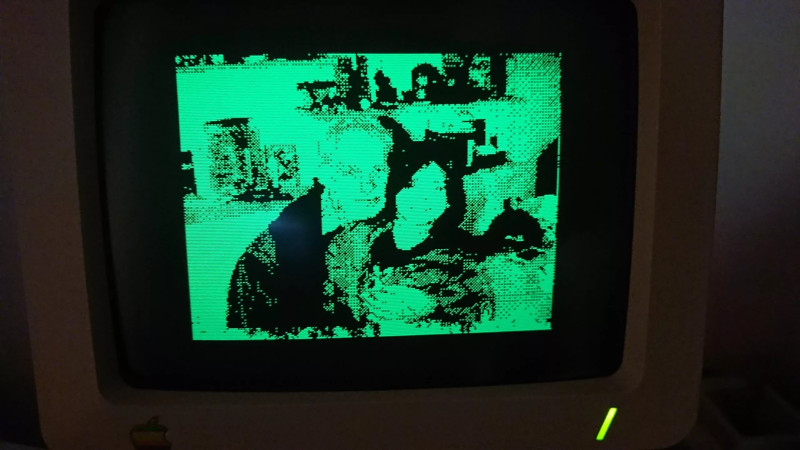Back in the very early days of consumer digital photography, one of the first stars of the new medium came from Apple. The QuickTake 100 used a novel flat form factor and at its highest resolution could only shoot 640×480 images, but at the time it was a genuine object of desire. It came in Windows and Apple versions, and to use the Apple variant required a Mac of the day with appropriate software.
The interface was an Apple serial connector though, so it was quite reasonable for [Colin Leroy-Mira] to wonder whether it could work with Apple’s 8-bit machines. The result is QuickTake for the Apple IIc, the product that perhaps Apple should have brought us in an alternative 1994.
Fortunately the protocol has already been reverse engineered and forms part of the dcraw package, however the process of extracting the code wasn’t easy. The full resolution and colour of the original pictures has to be sacrificed, and of course once the custom serial cable has been made it’s a painfully slow process transferring the pictures. But to get anything running in this way on such elderly hardware which was never intended to perform this task is an extremely impressive feat. We would have given anything for this, back in the 8-bit days.
If you have a QuickTake and want to use a more modern machine, we’ve got you covered there, too.















QuickTake 100 was released 1994, it sems.
By that time, 640×480 was full VGA/NTSC resolution and nothing to be ashamed about. For comparison, CD-i/Video CD players used less than that, too.
Okay, Kodak Photo CD format offered 4k resolution on CD-ROM, but that was another story.
My first cheap digital camera/web cam hybrid from the early 2000s couldn’t do VGA resolution, even.
It was limited to 160×120 to 320×240 pixels with a poor compression algorithm.
Webcams of the day were similar limited in resolution. 640×480 didn’t become popular up until 2006 or so. Youtube didn’t support 480p at that time, even.
My first digital camera was Quicktake 150 which could do 640×480 but only held so many pictures with the internal fixed storage that required batteries. Flash chips weren’t cheap back then.
I still have it along with original boxes and more.
The QuickTake 150 doesn’t need batteries to store images, just to power it. I have one and the contacts on the battery compartment are corroded, so I just power it via the mains adapter. Images are retained (as they’re stored in flash).
Actually, it took me several years to get around to getting the standard software onto an old enough Mac!
http://oneweekwonder.blogspot.com/2013_12_29_archive.html
-cheers from Julz
Support for Apple II is nice and good, I think, but the Apple IIgs was better suited for this task.
It was like a distant relative of the Macintosh.
I remember, sometime back in the late 70’s ‘We’ went to an Astronomy Gathering on Memorial Weekend in the hills behind Big Bear Lake in So Cal.. It was not expected to be anything fancy as it was a full moon weekend. Not to great for Observing.. We had an editor from Astronomy Magazine with us in our party. Had met him preparing for the Viking Mars Mission Landings.. ( Oh That was a few Lifetimes ago! ) We were looking at all the large Dobsonians looking at the Moon. Easy to see all the Hardware, as it was so bright outside…
We then stumbled on some guys watching an Oscilloscope inside a Van? Odd! It was some Fuzz Ball they were watching.. We realized it was a Picture of Saturn and it’s rings.. After chatting for a while, they identified themselves as JPL Boys trying out some new Hardware they were experimenting with. We were seeing Transmitted Pictures from the Telescope outside of the Van.. That Blew my Mind..
The discussion ensued that it’s never catch on, as Direct Viewing and Photography are the gold standard.. 45 Years ago..
Digital Photography has come a long way..
That oscilloscope might haven been an Slow Scan TV monitor.
Back in the beginning, they still used oscilloscope technology.
The CRT of an oscilloscope was basically being replaced by a radar tube that had ~8 second afterglow.
https://www.rigpix.com/textandimaging/robot_7080.htm
The JPL guys also had an radio amateur club station, transmitting pictures of Viking and Voyager probes.
There exist cassette recordings of a presentation, too, I believe.
https://tinyurl.com/ye4jkzmw
They also contain color images, recorded by using frame-sequential method (three grayscale images taken with a red/green/blue filter).
https://www.youtube.com/watch?v=1q66zazyJLU
Unfortunately, no modern SSTV software can handle that early method anymore.
Line-sequential method was already established when digital software solutions got popular.
Maybe an Robot Model 400C or 1200C may do.
Anyway, it’s possible to decode them in grayscale separately and use photoshop to get back color back by stacking them on each other.
Probably would work better on my atari 800xl
Which has color and the ability to use custom software defined display lists to draw lines on a screen
And just uses joystick port #2 while I can still use port #1
Or even sio but that would need active circuitry like an arduino…
Also technically the atari video circuitry has no true internal (hardwired) resolutions, it just draw scanlines, and will happily draw as many as you want, even if it’s not ntsc(50),pal(60), or secam compatible
Just will eat up cpu cycles, so you wan a dma system for it